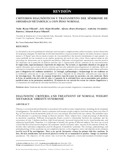Mostrar el registro sencillo del ítem
Criterios diagnósticos y tratamientos del sindrome de obesidad metabólica con peso normal
| dc.rights.license | http://creativecommons.org/licenses/by-nc-sa/3.0/ve/ | es_VE |
| dc.contributor.author | Reyna Villasmil, Nadia | |
| dc.contributor.author | Mejia Montilla, Jorly | |
| dc.contributor.author | Bravo H., Alfonso R. | |
| dc.contributor.author | Fernández Ramírez, Andreina | |
| dc.contributor.author | Reyna-Villasmil, Eduardo | |
| dc.date.accessioned | 2021-05-07T11:48:40Z | |
| dc.date.available | 2021-05-07T11:48:40Z | |
| dc.date.issued | 2021 | |
| dc.identifier.issn | ISSN:1690-3110 | |
| dc.identifier.uri | http://www.saber.ula.ve/handle/123456789/47426 | |
| dc.description.abstract | La obesidad es un serio problema de salud que está asociado a complicaciones cardiovasculares, incluso desarrollo de neoplasias malignas. El síndrome de obesidad metabólica con peso normal (sujetos con índice de masa corporal menor a 25 Kg/m2 pero obesos desde el punto de vista metabólico) fue descrito inicialmente el siglo pasado. La causa probable de este trastorno es un cambio pernicioso del estilo de vida y dieta. Estos sujetos tienen un alto porcentaje de alteraciones en la regulación metabólica. Diferentes investigaciones encontraron relación positiva del síndrome con la aparición de diabetes mellitus tipo 2, hipertensión arterial, aumento de las concentraciones de triglicéridos, hiperinsulinemia e hipertrofia de adipocitos. Por lo tanto, es importante identificar este grupo de sujetos afectados, pero existen diversos criterios que han sido utilizados para diagnosticar el síndrome: índice de resistencia a la insulina, aumento de la cantidad de grasa corporal, junto a otros componentes individuales utilizados para el diagnóstico del síndrome metabólico. La etiología, epidemiología y fisiopatología de este síndrome no es totalmente conocida por lo que el diagnóstico varía y depende de los elementos utilizados por cada una de las investigaciones. No existe un esquema terapéutico específico para los pacientes con esta condición. Hasta la fecha, la modificación del estilo de vida y el aumento de la actividad física son recomendados para producir modificaciones en los parámetros metabólicos. El objetivo de este artículo fue revisar los criterios diagnósticos y el tratamiento del síndrome de obesidad metabólica con peso normal. | es_VE |
| dc.language | Español | |
| dc.language.iso | es | es_VE |
| dc.publisher | SaberULA | es_VE |
| dc.rights | info:eu-repo/semantics/openAccess | es_VE |
| dc.subject | Síndrome de obesidad metabólica con peso normal | es_VE |
| dc.subject | Diagnóstico | es_VE |
| dc.subject | Tratamiento | es_VE |
| dc.subject | Obesidad | es_VE |
| dc.title | Criterios diagnósticos y tratamientos del sindrome de obesidad metabólica con peso normal | es_VE |
| dc.title.alternative | Diagnostic criteria and treatment of normal weight metabolic obesity syndrome | es_VE |
| dc.type | info:eu-repo/semantics/article | es_VE |
| dc.description.abstract1 | Obesity is a serious health problem that is associated with cardiovascular complications, including the development of malignancies. The metabolic obesity syndrome with normal weight (subjects with body mass index less than 25 Kg / m2 but obese from the metabolic point of view) was initially described in the last century. The probable cause of this disorder is a pernicious change in lifestyle and diet. These subjects have a high percentage of alterations in metabolic regulation. Different investigations found a positive relationship between the syndrome and the occurrence of type 2 diabetes mellitus, high blood pressure, increased triglyceride levels, hyperinsulinemia, and adipocyte hypertrophy. Therefore, it is important to identify this group of affected subjects, but there are several criteria that have been used to diagnose the syndrome: insulin resistance index, increase in the amount of body fat, besides other individual components used for diagnosis of metabolic syndrome. The etiology, epidemiology, and pathophysiology of this syndrome are not completely known, so the diagnosis varies and depends on the elements used by each of the investigations. There is no specifi c therapeutic scheme for patients with this condition. To date, lifestyle modification and increased physical activity are recommended to produce changes in metabolic parameters. The objective of this article was to review the diagnostic criteria and treatment of normal weight metabolic obesity syndrome. | es_VE |
| dc.description.colacion | 4-11 | es_VE |
| dc.description.email | sippenbauch@gmail.com | es_VE |
| dc.description.frecuencia | Cuatrimestral | |
| dc.description.paginaweb | http://www.saber.ula.ve/rvem/ | |
| dc.identifier.depositolegal | ppi. 200902ME4351 | |
| dc.publisher.pais | Venezuela | es_VE |
| dc.subject.institucion | Universidad de Los Andes | es_VE |
| dc.subject.keywords | Normal weight metabolic obesity syndrome | es_VE |
| dc.subject.keywords | Diagnosis | es_VE |
| dc.subject.keywords | Treatment | es_VE |
| dc.subject.keywords | Obesity | es_VE |
| dc.subject.seccion | Revista Venezolana de Endocrinología y Metabolismo: Revisión | es_VE |
| dc.subject.tipo | Artículos | es_VE |
| dc.type.media | Texto | es_VE |
Ficheros en el ítem
Este ítem aparece en la(s) siguiente(s) colección(ones)
-
Revista Venezolana de Endocrinología y Metabolismo. Vol. 19 Nº 1
Enero-Abril 2021


